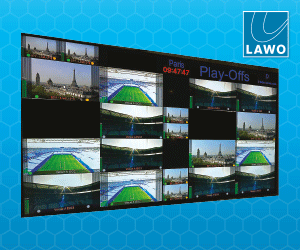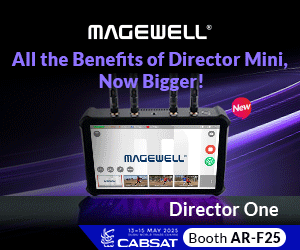BroadcastPro ME brings you an exclusive report on how Oman TV will manage its digital archive and production workflows with a state-of-the-art MAM system from Tedial. Last year, when Omans Ministry of Information (MOI) awarded the much coveted US $69 million HD contract to Sony Professional Solutions Middle East & Africa (PSMEA), Spanish media asset […]
BroadcastPro ME brings you an exclusive report on how Oman TV will manage its digital archive and production workflows with a state-of-the-art MAM system from Tedial.
Last year, when Omans Ministry of Information (MOI) awarded the much coveted US $69 million HD contract to Sony Professional Solutions Middle East & Africa (PSMEA), Spanish media asset management (MAM) specialist Tedial was also called in to jointly review the MOIs media workflow.
The project, which is scheduled for completion in November 2011, is aimed at introducing HD broadcast in the country for the first time while also simplifying and automating all of the processes within the new workflow without compromising on functionality and reliability. For Tedial, this project represents its first big win in the Middle East.
A key component of this project is managing the digital archive and production workflows for Oman TVs new HD-tapeless system, and Tedial has been tasked with achieving this. The new MAM solution from Tedial will replace an old tape-based system that is operated manually. The system will support both of Oman TVs channels and radio, says Rafael Dubois, Tedials sales director.
It will support Channel One, which is intended for general purpose programming (on-air 24 hours/day); Channel 2 dedicated to Sports (8 hours/day); and also, the News section of MOIs four associated radio channels. The production of content takes place in two separate sites: a central site (Digital TV studios in Muscat) and a regional station in Salalah, where the morning news is produced, explains Dubois.
The system will also archive video and audio files at both sites. This includes 20,000 hours of video HD, 20,000 hours of low-res video LR, and 10,000 hours of high-res audio in addition to 10,000 hours of low-res audio.
Although both the Muscat and Salalah facilities provide independent production and transmission services, they will be fully integrated by Tedials technology, delivering a single virtual system thats able to share media and act as a mirror for disaster recovery purposes, adds Dr. Emilio López Zapata, chief technology officer at Tedial.
All archived media can be shared with other areas, sites and users using Tedial tools. The MAM client application allows the users to search, catalogue, reproduce, edit and export media. The MPM (Media Process Manager) working in the background will provide the media and metadata thats processing and moving between the archive and all third party systems, including editing stations. The editors will have direct access to the archived media in the Tedial MAM and can easily with one click import and export media and metadata associated between different editing stations and the archive system, Zapata explains.
The MAM technology will allow Oman TV to take full advantage of file-based workflows by optimising and automating operational procedures such as automatic quality control, transcoding, indexing, creating EDLs, media logging and exchanging information with the traffic system, automation, news room and post production.
Zapata is the main architect behind the MAM solutions at Tedial.
We are a pioneer in the broadcast industry providing an enterprise-level integration platform based on IT architecture. Traditionally, MAM providers use wired logic connecting systems peer-to-peer. As such, when a change is made to third-party solutions, it can affect other interconnected components in the system.
Tedials MPM works as a middle layer integrating all of the third-party systems, which means theres no impact on the overall workflow structure should a replacement be required in the future. This not only helps when making future changes to the overall system, it also helps when upgrading the software of a key component, he adds.
The Tedial system itself is made up of four key components AST Hierarchical Storage Management (HSM); Tarsys Media Asset Management (MAM); Media Process Manager (MPM); and Ficus Business Process Manager (BPM). This will provide a complete turnkey solution for controlling, storing and processing Oman TVs media and its workflows.
The first component the HSM will control Oman TVs complex distributed storage system split between Muscat and Salalah consisting of robotic LTO libraries and disk storage servers.
AST is Tedials hierarchical storage manager. It handles and manages disk storage and one or more tape libraries, and is built on redundant and distributed architecture that balances requests among the different servers, a key point in a tapeless solution. Its main features are a multi-server architecture, Hierarchical Storage, Storage Group Management, Partial restores, Scalable System, request priority and so on, explains Zapata.
The second component Tarsys (MAM) manages the content and personalises its associated metadata according to the specific needs of Oman TV. Tarsys offers powerful searching tools and functionality such as cuts-only editing, browsing of low-res proxies with multiple audio tracks etc.
Tarsys Oracle database is built in a clustered configuration to provide high availability, redundancy and load balancing.
AST, working together with Ficus and MPM, can ensure that the media is always available in the main and the backup sites storage by using the database and by making specific media storage synchronisation steps at the appropriate moment during the executing of workflows. This means that should the main site fail, Salalah will always have the necessary media to resume operations and transmission from there, says Zapata.
Tarsys MAM is also a multimedia database that stands as the core of the archive system. This product stores the metadata of all clips managed by the system, including its cataloguing data and AST storage ID.
Tarsys is licensed according to the number of concurrent users (40 in Muscat and 17 in Salalah) and, can be expanded to include further users in the future if required.
Tarsys supports multi-language metadata, Customisable data models and multi-format media files. User can catalogue and search with Arabic and English information, Zapata adds.
The MPM forms the key third component of the system providing an important dual role. On the one hand, it automates all of the media moving within the facility between the archive and external systems such as the video server playout, post production and so on. On the other, it provides the interface layer amongst all the different components and technologies used by the facility.
For example at Oman TV, Tedials tight integration with Avids API will enable operators to ingest and edit metadata directly into Avids Interplay. This metadata will then be sent automatically with the media to the MAM. Users will catalogue and operate with one system and this information will be shared with the other.
MPM will also integrate the automation system (Pebble Beach) and video servers (EVS and SeaChange) at Oman TV in order to provide media to playout automatically from the archive and import media from the ingest area, says Zapata. The CTO further explains why MPM offers a unique solution in a challenging and incompatible environment.
In the broadcast world, each system uses a specified interface to communicate with other devices. It can be a standard or a proprietary protocol (API, web services, MOS, custom Communication Protocols etc). Interconnecting these systems is difficult because each vendor often has their own particular interpretation of the commands supported by the interface. In addition to this, the interface documentation is often not up-to-date and sometimes, when a vendor releases a new software version, this may not be totally compatible with the interface. To make things even more complicated, vendors often make small changes to the wrappers of universal file standard such as MXF, which render the files incompatible with other devices and applications from the same manufacturer or other third parties.
MPM solves the problem of integrating all of these systems by providing a middle layer protocol for exchanging media and metadata, which works as a bridge amongst all the systems areas. MPM also moves the media, and while doing so, it checks that the files are normalised to a format that is supported by all parties involved. This often requires rewrapping files on-the-fly using MPM media processing tools, he adds.
The Ficus BPM system sits above these three components automating all of Oman TVs production workflows. The overall Tedial system controls media creation integrated with traffic, digitisation of assets, automatic QC, subtitling, archive management and delivery of media required by automation playlists to the transmission servers.
The Spanish solution providers flexibility allows it to use the best integration tools provided by third-party vendors.
For example, the traffic system uses a web service which, in turn, is employed by Tedial providing a bi-directional interface to exchange media and metadata whilst maintaining information stored within the database.
At Oman TV, Tedials Ficus BPM software will integrate with the BTS traffic system, and automate each step of the production workflow.
Ficus produces work orders for operators based on the customers specific needs and the Tarsys MAM automates the availability of media and its associated metadata to the relevant production process at the right time and in the format required. At Oman TV, Ficus will integrate with BTS to exchange media information like playlists, ingestList (dublists) and so on. For each media, Ficus will generate a workflow; this workflow is composed by automatic and interactive workorder such as Autmatic Quality control, Manual Quality control, Cataloguing report and so on, explains Zapata.
What sets this technology apart from other MAM systems, according to the CTO, is its ability to deliver media to transmission, editing, archiving or any other area of the facility, whilst carrying out all the media processing, so that it arrives in the most efficient way in the correct format for the device thats going to use it. This is done automatically. The second overall element of this installation, according to him, is its multi-site capabilities.
Although the Muscat and Salalah facilities are independent, they can synchronise automatically and transparently. Media will be ingested in Muscat and copied to Salalah so that operators in either location can access and share material. The sites are joined by a private optical link. In the event of a system failure, the other site can act as a mirror adding an extra layer of security, he adds.
This project has its challenges, says Zapata. For one, Oman TV is building brand new facilities and this often has problems including construction delays, testing new infrastructure (electricity, A/C, cabling, etc).
The system will initially be built, configured and tested in Dubai. This will allow additional time to make sure the new buildings are ready to be used, explains Zapata.
The other challenge, according to him, is training. This system is vastly different to the current one. A large number of new, young Omani engineers will be trained and, although they will be more than capable of operating the system, many of them will lack practical experience working in a broadcast environment. The issue is not about the Tedial system per se but rather the whole operation.
Training needs to cover not only the content management solution but traffic, automation, video servers and so on. This is a lot to take in one go no matter how good the engineers are.
Therefore, Sony will start a comprehensive training programme well in advance based on a hands-on approach using the real system. Along with Sony, Tedial will train super users who can go on and train junior operators by themselves with support from Sony, he adds.
The Tedial systems have been designed to be supported remotely by VPN, adds Zapata. This is like having a virtual Tedial engineer on site 24/7, because our support team can see logs and other data just like being physically on site. In addition to this, Tedial has Arab-speaking engineers who no doubt will be of great help to Oman TV.
Although this is Tedials first project in the region, Zapata envisages more for the company. The Middle East is a natural market for Tedial because there is a large concentration of broadcasters that keep up with the latest developments of the technology, in particular, IT.
The next logical step in this evolution is to implement systems that optimise the execution of production workflows, thus reducing human errors and operational costs, whilst improving the speed of producing new content. Tedial not only has Arabic-speaking engineers, it has actively invested in the region by developing key practical functionalities that are normally overlooked by the competition such as developing the implementation of the RDI Arabic Thesaurus. This takes into account the unique syntax particularities of Arabic, which cannot be handled by thesaurus applications developed for other languages such as English, explains Zapata. When Oman TV goes on-air in November 2011, it will transmit in both SD and HD, and will mark the countrys 41st National Day celebrations. Although Omans new tapeless HD broadcast facility has been a huge undertaking for the MOI both technically and financially, it will act as a significant reference site for other broadcasters across the Middle East.















































































